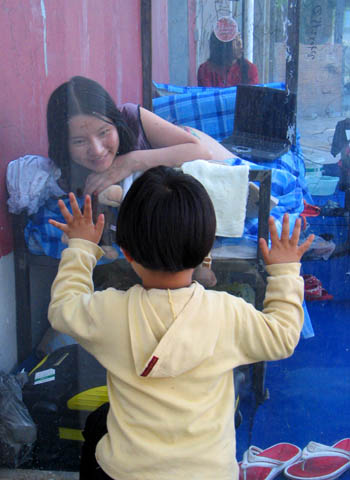Sent: Monday, January 24, 2011 9:48 PM
To: leaf@baymoon.com
Subject: RE: art students...
Glad you liked the show I'm going to post this exchange on the blog for the record.
Yeah Skype is easy. Give me a call tomorrow when you get an acct. and I'll plug in my camera and we can vid/chat.
AT
Alan Tollefson
Technical Director
University of La Verne Theater Arts
1950 Third St.
La Verne, Ca 91750
909.593.3511 ext.4552
atollefson@laverne.edu
________________________________________
From: leaf@baymoon.com [leaf@baymoon.com]
Sent: Monday, January 24, 2011 9:35 PM
To: Alan Tollefson
Subject: Re: art students...
i'd love to. i don't have a skype acct yet. easy?
i watched the vids. i am so proud of them, and you! this shit is wack,
in the best way!!! ahhh, the red chairs :)
possible additions (if appropriate):
it might be seriously disturbing and powerful if, for instance, the
tied/taped/desecrated people were already that way when folks entered the
space, and never came out of character. (the written-on gal had some
SERIOUS stage presence. she was practically a hero-martyr).
along the same lines, if aome of the artists were written
on/objectified/used in some non-standard way by the AUDIENCE rather than
the performers, similar to yoko ono's clothes being removed by the
audience... (any way to implicate, test, dirty, and offer redemption to
the audience) it would, i think, exponentially heighten the experience.
> They totally miss you and I told them to email. The are stoked for No.e on
> Wed. And their performance was awesome! They totally fucked that shit up!
> The viedo is up on youtube my channel is @ findtollefson check'em out and
> if
> you want to skype into class tomorrow (also findtollefson) you could give
> a
> mini crit. What do you think?
> Peace!
>
> AT
>
>
> On 1/24/11 6:34 PM, "leaf@baymoon.com" <leaf@baymoon.com> wrote:
>
>> hi al,
>> some of your (?) students contacted me via fb today. i wondered if it
>> was
>> part of some shenanigan. moheb said they did a fantastic piece where
>> they
>> fucked shit up. i'm intrigued! what's going on over there?!?
>> ~leaf
>>
>
>



